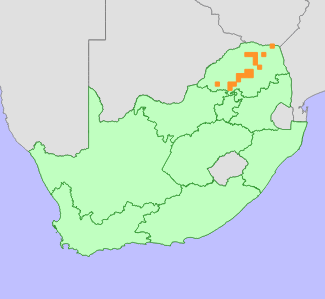|
Scientific Name | Aloe ammophila Reynolds |
Higher Classification | Monocotyledons |
Family | ASPHODELACEAE |
National Status |
Status and Criteria | Least Concern |
Assessment Date | 2014/06/03 |
Assessor(s) | L. von Staden |
Justification | Aloe ammophila is a widespread and common species that is not in danger of extinction. |
Distribution |
Endemism | South African endemic |
Provincial distribution | Limpopo |
Range | Aloe ammophila is endemic to Limpopo Province, where it occurs between Musina, Tzaneen and Thabazimbi. |
Habitat and Ecology |
Major system | Terrestrial |
Major habitats | Savanna |
Description | Rich sandy soils on flats, usually in grassland, but occasionally in open acacia thornveld. |
Threats |
| Aloe ammophila has lost habitat to urban expansion in parts of its range, and loss is ongoing around Polokwane and in Venda. It has also lost some habitat to agriculture in the past. Large areas of remaining suitable habitat is however protected in formal protected areas as well as private game reserves in the Waterberg and Soutpansberg, and it is unlikely to decline to extinction. |
Population |
This species typically forms large, dense colonies of up to 100 plants (Smith et al. 2012).
|
Population trend | Stable |
Assessment History |
Taxon assessed |
Status and Criteria |
Citation/Red List version | | Aloe ammophila Reynolds | Least Concern | 2015.1 | |
Bibliography |
Reynolds, G.W. 1936. A revision of Aloe transvaalensis, O. Kuntze, together with descriptions of three new aloes from the Transvaal, one from Natal and a new Leptoaloe from Zululand. Journal of South African Botany 2:113-124.
Reynolds, G.W. 1969. The Aloes of South Africa. A.A. Balkema, Cape Town.
Smith, G.F., Figueiredo, E., Klopper, R.R. and Crouch, N.R. 2012. Summer-flowering species of maculate Aloe L. (Asphodelaceae: Alooideae) in the Aloe zebrina-complex from South Africa: reinstatement of four names, and description of A. braamvanwykii Gideon F.Sm. & Figueiredo. Bradleya 30:155-166.
|
Citation |
| von Staden, L. 2014. Aloe ammophila Reynolds. National Assessment: Red List of South African Plants version 2024.1. Accessed on 2025/11/17 |
 Comment on this assessment
Comment on this assessment


